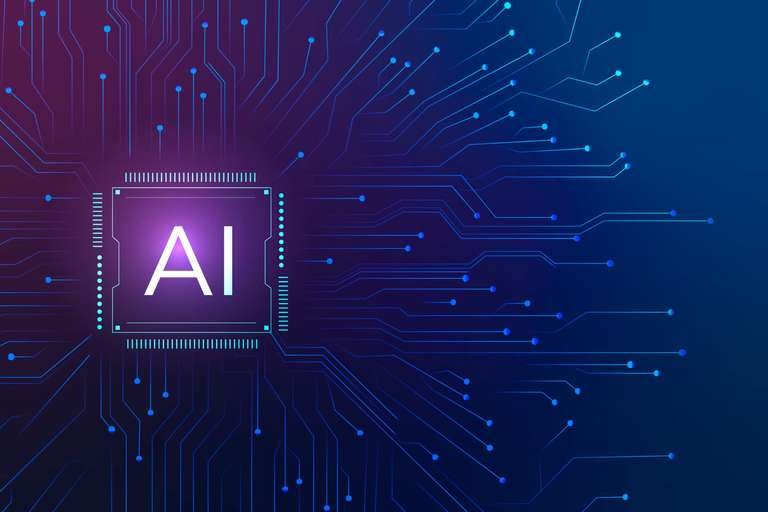Generative AI: All You Need to Know

If you don't follow the AI space closely but keep wondering about the increasing buzz surrounding generative AI, this post is for you!
Generative AI is the next big thing in data-driven innovation. Finding a place in Gartner's 2022 trends, it's predicted that generative AI will account for 10% of all data production by 2025 (that's substantially higher from less than 1% today).
AI technology has the potential to influence various aspects of human activity, from art and design to healthcare and music. For instance, generative AI could help us understand how to render new ideas for design architecture or how cancer cells work.
Let's further explore the concept of generative AI, its applications, advantages, shortcomings, and examples of companies using this technology to their advantage.
What is Generative AI?
The constantly evolving technological landscape is quickly leading us towards a new industrial environment where people are exploring and working with smart machines. These smart machines are nothing but devices embedded with various cognitive technologies such as artificial intelligence and machine learning.
Generative AI is one such technology that uses AI and ML algorithms that enable machines to create new videos, text, images, audio, or code. It's primarily driven by these algorithms and has the potential to identify the various underlying patterns of input and generate similar higher quality outputs.
Unsurprisingly, generative AI is being highlighted as an important tool that organizations across the board need to adopt. With several beneficial contributions to boast of across industries, it's the new buzzword in today's business environment.
What are the Types of Generative AI Models?
Presently, there are three prominent frameworks or models of generative artificial intelligence, as mentioned below:
Generative Adversarial Networks
Generative adversarial networks (GANs) refer to an approach of generative modeling that uses deep learning methods (neural networks).
Generative modeling is primarily an unsupervised learning task in machine learning technology that involves automatic discovery and learning of the various patterns in input data.
Other highlights of this model are as follows:
GANs are an intelligent way of training a generative model by framing the problem as a supervised learning problem with two different sub-models.
Among these two models are the generator model, which is trained to generate new examples. The other one is the discriminator model, which mainly tries to classify examples as either real (from the domain) or fake (generated).
Applications of GANs:
Image-to-image translation, such as converting or transforming pictures of daytime to nighttime.
Generating photo realistic images of various scenes, objects, and people that are difficult to identify as fake, even by humans.
Transformer-Based Models
Transformer-based models are essentially neural networks that work by learning context and meaning by closely tracking relationships in sequential data.
Other highlights of this model are as follows:
In this model, transformers such as GPT-3 and LaMDA work on cognitive attention and measure the significance of the input data parts differentially.
These transformers are trained to understand the language or image and generate texts or images from massive datasets.
Applications of transformer-based models:
Transformers can translate text and speech in near real-time, thus opening classrooms and meetings to diverse and hearing-impaired attendees.
They can help researchers better understand the chains of genes in DNA or amino acids in proteins, which can speed up drug design.
Transformers can detect trends and anomalies to prevent instances of fraud, make online recommendations, or improve healthcare outcomes. For instance, using GANs, X-rays or CT scans can be converted to photorealistic images with sketch-to-photo translation. This helps diagnose dangerous diseases such as cancer in their initial stages due to a better quality of images.
Variational AutoEncoders (VAEs)
Variational AutoEncoders are generative models like GANs that work by building on neural network autoencoders made up of two different neural networks—encoders and decoders. They're the most effective and useful process for creating generative models.
The encoders in VAEs optimize for more efficient ways of representing data, whereas the decoders optimize for more efficient ways of regenerating the original data set.
Other highlights of VAEs:
The VAE generative model lets you design complex generative models of data and fit them into large datasets.
Using generative modeling, a VAE can generate new images by sampling from the latent distribution.
Applications of VAEs:
Signal processing use cases
Anomaly detection for predictive maintenance
Security analytics applications
The Benefits of Generative AI
Among the main benefits of generative AI are the following:
Robotics Control
One of the advantages of generative AI modeling is that it helps reinforcement MI models comprehend much more abstract concepts (without being biased) in both simulations and the real world.
Identity Protection
Generative AI as a technique offers protection for people intending not to disclose their identities while working online or interviewing. It does this by creating avatars, thus concealing the real identity of people.
Improved Quality of Output
Generative AI models work on the shuttle patterns of operation, which are utilized in self-learning GANs and are useful in getting better, high-quality images, audio, or video, even if the input content is not perfect.
Upgraded Reinforcement Machine Learning
The concept of reinforcement machine learning is based on offering rewards for desired actions and doling out punitive actions for unwanted ones. Although bias is still present, generative AI techniques make it easy to eliminate or considerably reduce this bias.
Reduced Financial and Reputational Risks
Yet another benefit of generative AI tools is their capability to quickly detect malicious or suspicious activities using predefined algorithms and rules, thus preventing damage to businesses or individuals.
Shortcomings of Generative AI
While generative AI makes it easy for machines to create new content effectively, it also comes with its own set of limitations, some of which are discussed below:
Difficult to Control
Generative AI models like GANs don't always generate desired results. These models are unstable, and it's difficult to control their behavior. Further, this makes it harder for them to generate the expected output sometimes.
Security Concerns
There are chances that people with malicious intent might use generative AI for deceitful purposes, such as to create fake news or commit fraudulent activities, such as scamming people financially or medically.
Pseudo Imagination
Generative AI algorithms require a vast amount of training data to perform various tasks. GANs still cannot create entirely new outputs; rather, they can only combine what they already know in new ways.
The Applications of Generative AI
Generative AI has multiple practical applications in a range of domains. Some of its prominent use cases are as follows:
Image Generation
Generative AI allows you to transform text and generate realistic images based on the subject, style, setting, or location specified. This makes it possible to generate the required visual material quickly and easily.
These visual materials can then be used for commercial purposes, making AI-generated image creation a useful strategy in fields such as design, advertisement, media marketing, education, etc.
Text to Speech
The GAN model allows the production of realistic speech by processing human speech with linguistic features (phonetic and duration information) and pitch information. The generator then learns to convert the linguistic features and pitch information to raw audio.
TTS generation has a range of business applications, such as marketing, podcasting, education/e-learning, etc.
Audio Generation
Generative AI can be used to process audio data by converting audio signals to image-like 2-dimensional representations known as spectrograms. This allows you to use algorithms specifically designed to work with images, such as convolutional neural nets (CNNs), for audio-related tasks.
You can use this approach to transform either people’s voices or change the style or genre of a piece of music.
Video Generation
Since a video is a set of moving visual images, it can also be generated and converted similarly to images.
One of the most prominent use cases of generative AI here is video frame prediction, where you can take a video frame from a video game and use GANs to predict what the next frame in the sequence will look like and accordingly generate it.
Synthetic Data Generation
While the amount of data generated today is huge, there's still the prevailing issue of getting enough quality data to train ML models. The solution to this problem can be synthetic data generation, which is subject to generative AI.
Such synthetically created data can be instrumental in developing self-driving cars, for instance, as they can use generated virtual world training datasets for pedestrian detection.
Examples of Companies Using Generative AI
Here are some of the prominent companies and startups leveraging generative AI to their advantage:
Murf AI - AI Voice Generator
Murf AI is a text to speech platform that harnesses the power of generative AI and deep machine learning algorithm to generate ultra-realistic voiceovers across a range of 120+ voices in over 20 languages.
The voice generator can be used to create voiceovers for any type of content, from YouTube videos to e-learning content to presentations to podcasts to advertisements and commercials, and more.
Rephrase.ai - AI Video Creator
Rephrase.ai builds generative AI tools to create professional videos. It uses deep learning techniques to create digital avatars of actual humans that can then be used for synthetic video content with only text as input.
The platform also allows you to create hyper-personalized videos at scale to drive engagement and business efficiency.
OpenArt - AI Image Generator
OpenArt is an AI image generator platform for AI artists and art enthusiasts. It's a startup that leverages state-of-the-art technologies like DALL·E 2, which makes amazing art creation more accessible for everyone.
Musico - AI Music Generator
Musico is a Dutch startup leveraging generative AI to create new, copyright-free music. The company has two products—a software engine that uses algorithms and machine learning models to generate a wide range of music, and a mobile app, which is used for AI-assisted music production.
AI Dungeon - AI Fantasy Simulator
Unlike other games, which allow you to experience a game designer-created world, AI Dungeon allows you to direct the AI to create characters, worlds, and scenarios for your character to interact with.
The Way Forward
Today, generative AI is finding applications in a range of fields, such as marketing, education, healthcare, communication, podcasting, and defense security. However, the way in which generative AI is advancing is set to disrupt many more industries than we can imagine.
If experts are to be believed, the applications of generative AI could dramatically improve AI efficiency and reduce biases in the future.
As the AI market is growing globally and is predicted to hit the value of $190 billion by 2025, there's no doubt that generative AI will continue to play a key role, especially as organizations begin to understand the value it can deliver.
FAQs
1. Who created generative AI?
The generative adversarial network (GAN) model was first designed by Ian Goodfellow and his colleagues in June 2014.
2. Where is generative AI used?
Generative AI is used across industries (manufacturing, pharma, genetics research, and many more) to generate new text, video, and audio successfully. Numerous companies are also using this technology to develop applications and generate virtual spaces for game designs.
3. What are some common challenges generative AI is facing?
Some of the challenges generative AI faces include pseudo-image generation, security obstacles, data privacy concerns, control limitations, and ethical issues.



